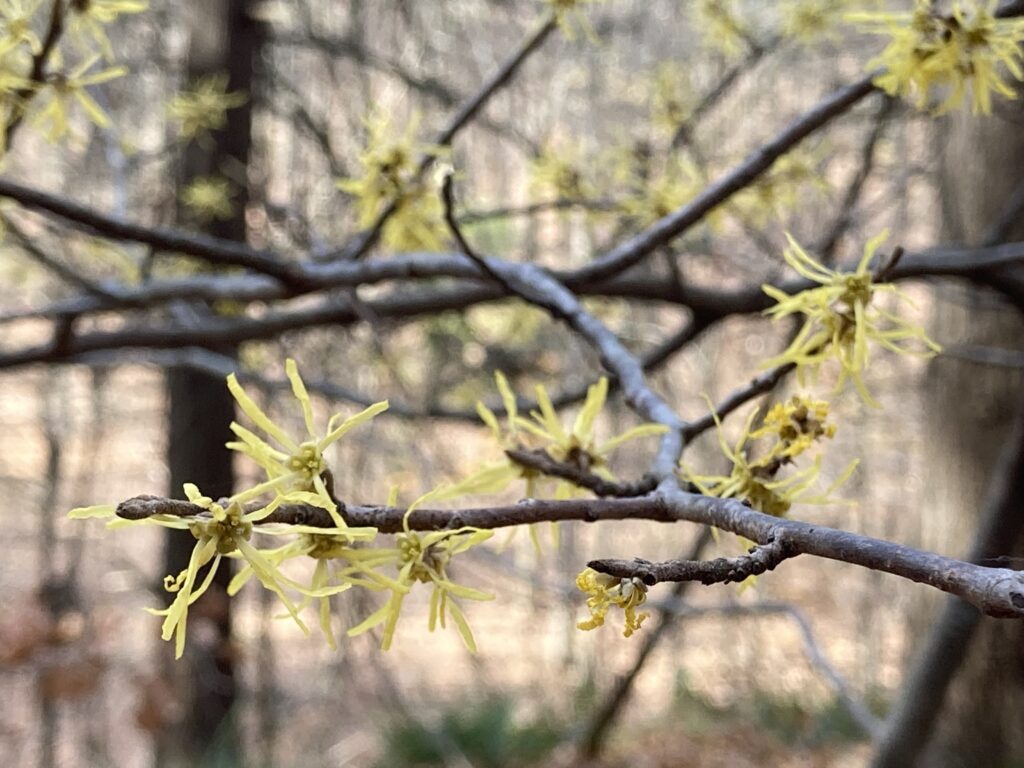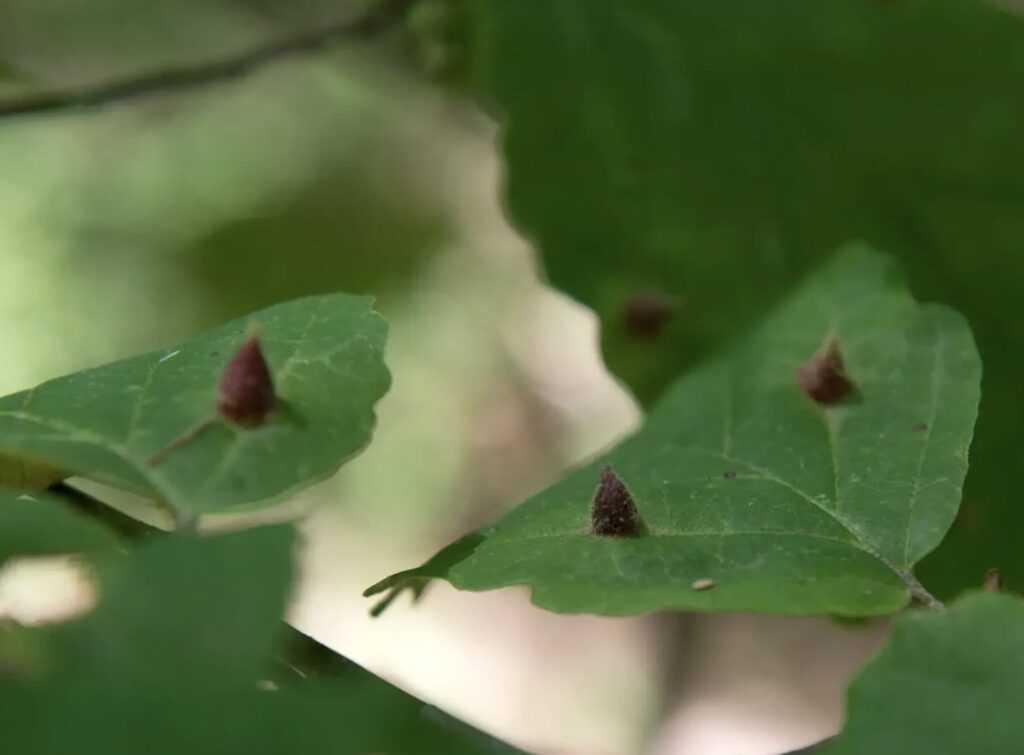Almanac: Final Flowers

Witch hazel blooming in the woods on the western side of Mt. Toby this week. Photo: Stephen Braun
On a hike up the western side of Mt. Toby this week I saw many witch hazel trees covered with the strange ribbon-shaped yellow blooms that are the last flowers to open in this region before the snow flies.
Witch hazel is a small understory tree with no regular shape, crooked branches, and slightly lobed leaves. In the summer, it’s easy to overlook. But the plant comes into its own in the late autumn, flowering long after other plants have died back or gone dormant and after its own leaves have dropped. Of course, most insects, too, have either died or gone dormant. How is such late flowering a successful pollination strategy?
The answer is that witch hazel isn’t pollinated by insects—it’s pollinated by a moth that, itself, is quite a wonder of adaptation. A type of winter owlet moth called a sallow can remain active late into the year by shivering to generate heat, raising its internal temperature as high as 86 degrees F. The owlet moths pollinate witch hazel flowers at night, supposedly attracted by the flowers’ scent. I stuck my nose into a lot of witch hazel flowers this week (it’s been a great week for hiking!) and I don’t detect any aroma. Clearly (and not surprisingly) the moths have better senses of smell than I do.
Interestingly, the name “witch hazel” has nothing to do with pointy-hatted crones. The term “witch” derives from the Middle English word wiche, which comes from the Old English wice, meaning “pliant” or “bendable.” This highlights the flexible nature of the plant’s branches, rather than any association with witchcraft or magic. “Hazel” refers to its resemblance to true hazel trees (genus Corylus), which belong to a different botanical family but share some visual characteristics, particularly in their leaves.
The name may also relate to the use of Y-shaped witch hazel twigs to find underground water, the “bending” of the twig downward indicating the water. Some sources say that early New England settlers observed Native Americans using this technique and adopted it, using the word “dowsing” for the activity.
Native Americans are also reported to have brewed tea from witch hazel leaves and bark using it as a cure-all for scratches, bug bites, skin irritations, colds, coughs…you name it. The colonizers learned this, too, and started using distillations of witch hazel bark for the same curative purposes. In the mid-1800s a minister named Thomas Dickinson opened a witch hazel distillery in Essex, Connecticut. The company he formed thrived and still exists today as the American Distilling company, still in Connecticut, which sells a range of witch hazel products used for their mildly astringent and soothing properties.
Last night, like millions of other folks, I had a steady stream of little witches trooping up to my door in search of treats. That reminded me of a final interesting thing about witch hazel, which I observed for the first time about a month ago on a hike in the lovely Bear Swamp area near Ashfield. The witch hazel leaves were still green then, and I noticed many tiny, black cones on the tops of some of the leaves.

Back home I looked them up and discovered that they are called “witch hat galls.” It’s amusing that these galls in the shape of actual witches’ hats are only found on a plant called “witch hazel” for reasons that have nothing to do with actual witches. The galls are a cellular response of the leaf to chemicals secreted by an aphid, Hormaphis hamamelidis. The female aphid deposits the chemicals, along with an egg, into the leaf, which reacts to the injury by forming a cone-shaped gall that then gets populated by a sooty black mold. The cone protects the egg all winter, then provides some nutrition for the larva, which emerges in the spring.
There’s still plenty of mild weather ahead and the witch hazel flowers should stick around for another couple of weeks, so if you get a chance to get out on a trail keep your eyes peeled for these unusual-looking harbingers of colder days to come.
Almanac is a regular Indy column of observations, musings, and occasional harangues related to the woods, waters, mountains, and skies of the Pioneer Valley. Please feel free to comment on posts and add your own experiences or observations.

For those of us not able to get out to the trails, Steve Braun is an essential hiking companion. And for those of us upset with the way our species is impacting nature he reminds us of how well nature manages without us. And all of this with a generous humanistic spirit!
The “witch hat” galls gave Steve’s enthralling story a nice surprise ending!!!
Besides the wild species Steve found, which grows mainly in eastern North America, another is found in the Ozarks, and two more in eastern Asia (China and Japan), plus (it seems) many hybrid varieties cultivated by horticulturalists for west coast gardeners:
https://pacifichorticulture.org/articles/witch-hazel-queen-of-winter/
On my way back to the parking lot at Mercy Hospital last week, I noticed that the witch hazel planted by Memorial House was in bloom. Alas, as expected, there was no smell. I assume these shrubs are some cultivar of the North American witch hazel.
But there is also a witch hazel that is native to China: Hamamelis mollis. While similar in form, it blooms at the very end of winter or very beginning of spring, and these flowers are fantastically fragrant! They remind me of the smell of orange blossoms that fill the air in Seville in early March — to the point that on occasion I am tempted to close my eyes, inhale deeply, and see if doing so will magically transport me to Spain. These shrubs can be found in Amherst, in the Middle School Arboretum created by Phil Covelli and Robert Lord, where I have watched them bloom at winter’s end for 30 years.